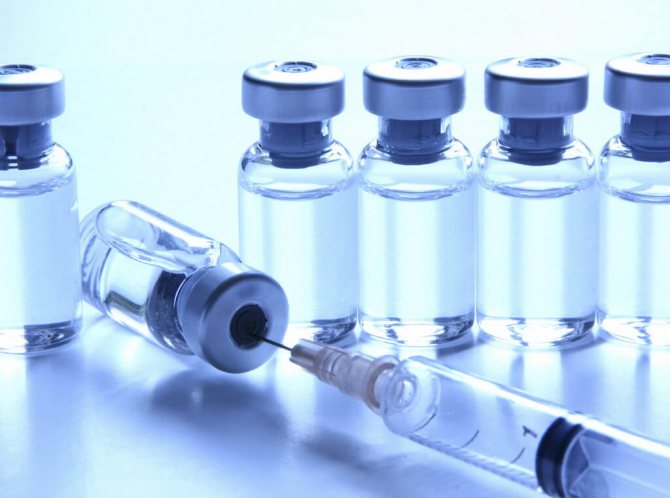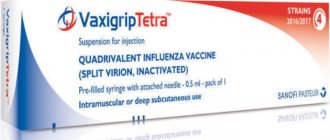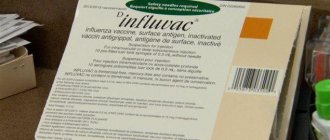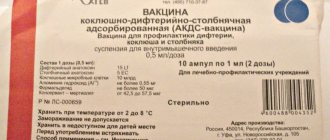The text is presented for informational purposes only. We strongly urge you not to self-medicate. When the first symptoms appear, consult a doctor. We recommend reading: “Why you can’t self-medicate?”
Vaccine prevention of influenza is the introduction into the human body of a biologically active drug for prophylactic purposes, which is capable of forming short-term immunity to the body’s ability to fall under the influence of the influenza virus. Vaccination is considered the most effective preventive measure against this disease. The flu itself is much more dangerous than many people think, since this disease can cause severe consequences, complications and death. Medical science is constantly improving methods for preventing this disease, but to date scientists have not yet found anything better than vaccination.
Types of vaccines
In modern pharmacology, there are a large number of vaccines against the influenza virus. They all differ in their ability to influence the virus to prevent disease caused by different strains of the virus and the mildness of their effect on the body. To correctly select a flu vaccine, it is best to consult a doctor who will help determine for a particular person which vaccine in his case will be the most effective and will cause the fewest side effects.
All vaccines against the influenza virus help build immune defenses in the body. The choice should be made based on whether a person has an allergic reaction to chicken egg white, which is part of many vaccines, or to specific components of the drug.
By type, vaccines are live, that is, containing a dose of a live attenuated virus, whole virion based on chicken protein, split (protein-free) and subunit. The most popular live vaccine is the Russian drug “Live influenza allantoic vaccine” for intranasal administration, which helps protect simultaneously from 3 strains of the virus. This vaccine can only be administered to the body after the age of 3 years. The whole-virion Russian vaccine “Grippovac” can be used only from the age of seven and only in cases where the patient, after preliminary tests, does not have an allergy to chicken protein or aminoglycosides. If allergic reactions to chicken egg whites are detected, patients are vaccinated using split-split vaccines, such as the French Vaxigrip, German Begrivak or English Fluarix, which do not use egg whites. The most well-known subunit vaccines include Dutch (Influvac) and Russian (Grippol, Grippol Plus) drugs.

The vaccine is poorly tolerated by the human body only if during the administration of the drug the conditions of this procedure were violated, or after vaccination the patient did not comply with certain doctor’s instructions. If all immunization conditions are met, then any vaccine is tolerated quite easily.
Vaccination
Most often, vaccination against influenza takes place in a clinic, but vaccination can be done in any other equipped institution if the patient wishes, for example, in a medical office of an enterprise, school, kindergarten, in a hospital, or a private medical clinic.
If the patient is at risk for possible influenza infection, vaccination should be planned and carried out in advance. On the eve of the start of the cold season (the potential season for the spread of the influenza virus - in late November - early December), such patients are invited to clinics, they are examined by a doctor, and then, if there are no health problems at the time of the examination, they are vaccinated.
If a person is not included in the risk group, but wants to independently protect himself from influenza vaccination, he needs to purchase any desired drug for vaccination and go to any medical institution, where he will be examined by a specialist and then given a referral for vaccination or undergo vaccination available for seasonal prophylaxis with the drug.
The flu vaccine is administered subcutaneously or intramuscularly into the deltoid muscle area. In the case of subcutaneous administration of the vaccine, the drug is injected into the area under the shoulder blade or into the shoulder. Some live vaccines can be administered intranasally by specialists.
It is important to remember that the risk category for influenza includes all children without exception.
However, vaccinating children against influenza has its own characteristics:
- young children can be given the flu vaccine no earlier than six months of age;
- Almost all flu vaccinations for young children are given twice;
- For children, the vaccine is administered only in the femoral area.

Such features are explained by the presence of maternal immunity in a child up to 6 months of age, and the need for revaccination a month later to strengthen immunity. The femoral area is optimal for anti-influenza vaccination in children due to the fact that if the body reacts to the administered drug, it is easiest to carry out resuscitation measures in this area (apply a tourniquet).
At the age when children attend kindergarten, they especially need a flu shot, since they do not yet have immunity to many diseases, and the large number of children contributes to the spread of a large number of infections. In the case of influenza, in this state of affairs, an outbreak of an epidemic of the disease is possible. The most ideal situation is when all members of the children's team are vaccinated against influenza. Together with them, all adults who are in constant contact with children - parents, brothers and sisters, teachers - should also be vaccinated. Before vaccinating a child, three days before, he should have minimal contact with third parties who can infect him with any infection. The same should be done for three days after vaccination - crowded places must be excluded from the child’s environment during this period of time. The most optimal situation is when the child, after vaccination, remains at home for a week under the supervision of his parents. If these rules are followed, stable specific immunity will be formed.
Flu vaccination: pros and cons
Pros of the flu vaccine:
- Flu prevention
According to the Centers for Disease Control and Prevention (CDC), getting a flu vaccine is the most effective way to avoid getting the flu. Read the article about how to support your body and strengthen your immune system using “prevention of colds and flu in winter.”
- Feeling less sick
After vaccination, it is still possible to become infected with the flu. However, if you get the flu, your symptoms will be milder if you have been vaccinated.
- Reducing the risk of hospitalization or complications for certain people
Influenza vaccination has been shown to reduce the risk of influenza-related complications or hospitalization in some groups. These include:
- elderly;
- pregnant women;
- children;
- people with chronic diseases such as diabetes, asthma and cardiovascular diseases.
- Protection within society
When you protect yourself from the flu by getting vaccinated, you are also protecting those who cannot get vaccinated for certain reasons. This includes those who are too young to be vaccinated and those who are not eligible for the vaccine. This is called herd immunity.
Disadvantages of flu vaccination:
- There is still a risk of getting the flu
Sometimes you can get a flu shot and still get sick. It takes about 2 weeks for your body to develop immunity after vaccination. During this time, you can still become infected with the flu.
- Severe allergic reaction
The flu shot has its consequences. Some people may react negatively to it. If you have a negative reaction to a vaccine, symptoms usually appear within minutes to hours after vaccination. The flu vaccine may cause the following side effects:
- labored breathing;
- wheezing;
- cardiopalmus;
- rash or hives;
- swelling around the eyes and mouth;
- feeling weak or dizzy.
If you experience these symptoms after vaccination, contact your doctor. If the reaction is severe, seek emergency medical attention.
- Guillain-Barre syndrome.
Guillain-Barré syndrome is a rare disease in which the immune system begins to attack its own peripheral nerves. In very rare cases, vaccination against the influenza virus can cause this disease.
If you have already had Guillain-Barre syndrome, talk to your doctor before getting the vaccine.
Contraindications to vaccination
There are several contraindications to influenza vaccination, as with any other vaccines.
Such vaccination is absolutely contraindicated:
- allergy sufferers who are sensitive to chicken protein (applies only to vaccines based on it);
- children under 6 months of age;
- in cases of previous reactions to components of a similar drug.
Temporary vaccination is contraindicated for those who are currently suffering from any infection or are suffering from an exacerbation of chronic diseases. Only 2-4 weeks after complete recovery is it recommended to consider the possibility of vaccination.
Contraindications for administering the vaccine do not include cancer, pregnancy, or immunodeficiency. Such diagnoses, on the contrary, serve as a reason for mandatory vaccination, since such people are at increased risk of contracting influenza and developing severe complications of this infection.

You cannot be vaccinated at the onset of any respiratory disease, since usually its onset is difficult to clearly determine and find out immediately what kind of disease a person has become infected with. To get a flu shot, you must recover from the actual infection, wait 14 days, and then use the vaccine.
Vaccination during pregnancy and breastfeeding
Vaccination is the only method of safe and effective prevention of influenza in pregnant women, and has been performed in different countries for more than 20 years with inactivated split vaccines. This statement is based on a significant reduction in the prevalence, severity and consequences of influenza in pregnant women, with potential benefits for the babies they give birth to. According to WHO, pregnant women are a priority group to be vaccinated against influenza. This provision is based on a significant reduction in the prevalence, severity and consequences of influenza in pregnant women, with potential benefits for the babies they give birth to. Most experts agree that during the period of bearing a child, you can get vaccinated against influenza in the second or third trimester; it is better to try not to touch the first trimester.
In the case of a nursing mother, vaccination becomes a very necessary manipulation due to the fact that the body, weakened by childbirth, is more susceptible to infection by viruses. Even if enough time has passed after childbirth (several months), the immune system usually does not have time to restore itself due to the woman’s nervousness and lack of sleep. This may make a nursing mother more susceptible to influenza infection. By getting vaccinated, a woman will not only protect herself, but also protect her child from the virus, through the supply of antibodies produced from mother’s breast milk.
But flu vaccination is considered the most desirable and effective when planning pregnancy. During this period, the woman’s body is at the peak of its health, the immune system is not weakened in any way and is able to effectively form the necessary antibodies to any virus. It is important to avoid influenza during pregnancy, since its consequences can be very negative for the child, leading to intrauterine infection and even miscarriage.
High-quality and timely vaccination can save the health, and even life, of the mother and the unborn baby, so experts recommend thinking about vaccination when a woman is just starting to plan a pregnancy.
After vaccination
What should you do if you feel sick after getting the vaccine?
If you feel unwell, you should contact the doctor accompanying the patient as part of the study as soon as possible. Contacts are indicated in the information consent or leaflet that is issued after vaccination. Specialists will monitor the health of all volunteers for six months. To do this, they use a mobile application, telephone, and telemedicine consultations. Information about the patient's well-being is automatically downloaded into his electronic record.

Can I get other vaccinations, such as yellow fever, if I have already received the coronavirus vaccine?
Vaccination against other diseases is permitted. There should be 30 days between vaccinations.
Is self-isolation necessary before or after getting vaccinated against coronavirus?
No, you can lead a normal life. But do not forget about the general current precautions: social distance and wearing a mask in public places.
Do I need to wear a mask and gloves after vaccination?
After vaccination, it is necessary to comply with general sanitary and epidemiological requirements, that is, maintain social distance and use a mask and gloves in public places.
How does the vaccine work?
The effect of the influenza vaccine is not aimed at destroying the virus that already exists in the body. Vaccination is designed to mobilize protective immune functions, forming antibodies even before encountering the most common infectious disease.

The compositions of influenza vaccines can vary greatly due to the fact that their base can be either live or inactivated. Inactivated samples are artificially bred by cultivating the virus in a chicken embryo, then purifying it of impurities and rendering it harmless using ultraviolet rays or formaldehyde. The viruses used in vaccines are inactivated and do not cause influenza. However, mild side effects may occur, including a local reaction at the injection site. Live vaccines are whole-virion vaccines with viral virions, split protein-free, subunit vaccines with two viral proteins involved in the formation of an immune response to the virus in the body.
The period for administering the influenza vaccine must be chosen based on WHO forecasts regarding the upcoming epidemic, as well as on the instructions for the specific vaccine, which clearly states the period for developing the body's immune response. As a rule, this period ranges from 10 to 30 days.
The duration of the vaccine's effect also depends on the specific drug. Most often, antibodies to influenza are produced after vaccination for up to 6 months. However, in modern pharmacology there are drugs that protect health for 9-12 months.
Anti-influenza vaccination, subject to certain conditions, is the most effective method of protection against the disease. Experts include such conditions as maximum vaccination coverage of the population of all ages, the possibility of isolating sick people from other family members or team members, protection from contacts at the time of vaccine administration, when many come to the clinic and encounter already sick people before vaccination, high awareness of influenza vaccine prevention.
After using a subunit or split vaccine, the patient may experience a local reaction at the injection site for some time. It is completely normal and does not require medical attention as it goes away on its own. Such discomfort usually disappears within 2 days.
Flu vaccines have very low reactogenicity, meaning they rarely cause complications.
The individual characteristics of each human body can sometimes lead to such post-vaccination reactions as:
- allergy to the components of the drug;
- local reaction - infiltration at the injection site;
- the occurrence of mild catarrhal manifestations in the form of low-grade fever, sore throat and other symptoms that go away on their own within 2 days and occur only after the use of live vaccines.
In general, the presence of side effects is, in most cases, a normal reaction of the body to an antigen, reflecting the process of developing immunity.
True contraindications
home
Information
For patients
General issues
True contraindications
Attitudes towards contraindications to vaccination are constantly changing - there are fewer and fewer reasons for “exemptions”, the list of diseases exempt from vaccinations is becoming shorter and shorter. And what was previously a contraindication, for example, chronic diseases, is now, on the contrary, an indication for vaccination.
Why is the list of contraindications constantly decreasing?
- In children and adults with chronic diseases, infections that vaccines protect against are much more severe and lead to more complications. Examples include a more severe course of measles in patients with nutritional disorders infected with tuberculosis and HIV, whooping cough in premature infants, rubella in patients with diabetes mellitus, influenza in patients with bronchial asthma, pneumococcal infection in patients with blood diseases, viral hepatitis in patients with liver diseases, chickenpox in patients with leukemia. It is simply illogical to protect such children from vaccinations.
- Modern vaccinology does not stand still - the technology of production and purification of vaccines is being improved, the concentration of ballast substances is being reduced in favor of the necessary components. An example is the Vaxigrip vaccine - in 1997, the vaccine purification technology was changed, due to which it was possible to reduce the concentration of ballast egg white to undetectable values. Allergy to chicken egg whites, therefore, is gradually becoming a relative contraindication from an absolute contraindication to the flu vaccine.
- Practice shows the normal course of the post-vaccination period in patients with chronic diseases. The experience of mass vaccinations within the framework of the WHO Expanded Program on Immunization in African countries with a ratio of “absolutely healthy” to “sick” equal to 1:1 has shown that vaccinations with modern vaccines do not increase the risk of worsening the course of underlying diseases.
All contraindications are divided into:
- True. These contraindications are listed in the instructions for vaccines and in guidance documents (orders and international recommendations). Typically caused by certain components of vaccines. For example, the pertussis component of DPT and progressive neurological diseases.
- False. Contraindications that are not. As a rule, their authorship belongs to doctors and patients who “protect” from vaccinations on the basis of universal and general scientific considerations - “he is so small”, “he is so sick”, “since he is sick, it means his immunity is reduced”, “since there were reactions in the family , which means all family members will have reactions.” On the other hand, these are contraindications that have developed due to tradition - for example, perinatal encephalopathy.
- Absolute. Absolute contraindications. If there are such contraindications, this vaccination is not carried out under any circumstances.
- Relative. True contraindications, the final decision on which is made by the doctor based on other factors - the proximity of the epidemic, the degree of likelihood of contact with the source of infection, the likelihood that the patient will be able to be vaccinated next time, etc. An example is an allergy to chicken egg whites, which is a contraindication to flu vaccinations. In a situation where the risk of complications and death due to influenza in a given patient exceeds the risk of an allergy to the components of the vaccine, abroad the latter contraindication is neglected and the vaccine is given, carrying out special allergy prevention.
- Temporary. There is a contraindication at the moment, but over time it can be removed. For example, ARVI, during which vaccination is not recommended, but after recovery, vaccinations are not contraindicated.
- Permanent. Contraindications that will not be removed over time. For example, primary immunodeficiency, caused by a profound defect in the immune system.
- Are common. Contraindications common to all vaccinations. In practice, general contraindications include the presence of an acute infection accompanied by an increase in temperature, exacerbation of a chronic disease or acute illness.
- Private. Contraindications that apply only to a given vaccination or a specific vaccine, but do not apply to all others. For example, pregnancy, which is a contraindication to vaccination with live vaccines (rubella, yellow fever), but not inactivated ones (influenza, hepatitis B).
True contraindications to vaccinations
Guidelines MU 3.3.1.1095-02 3.3.1. Vaccine prevention “Medical contraindications to preventive vaccinations with drugs from the national vaccination calendar” (approved by the Chief State Sanitary Doctor of the Russian Federation on January 9, 2002)
1 area of use
1.1. These guidelines are intended for medical workers of medical institutions, regardless of departmental subordination and forms of ownership, who have permission to carry out preventive vaccinations for children, adolescents and adults, as well as for specialists of the state sanitary and epidemiological service monitoring the organization and implementation of preventive vaccinations .
1.2. These guidelines contain requirements for taking into account medical contraindications and carrying out preventive vaccinations against a number of infectious diseases.
1.3. The requirements set out in the guidelines are aimed at ensuring the effectiveness and safety of vaccinations, as well as reducing the number of unjustified medical exemptions from preventive vaccinations.
2. Basic provisions
2.1. The use of modern highly effective, low-reactogenic vaccines for mass immunization has led to a sharp reduction in the frequency of severe reactions and complications that occur in the post-vaccination period. Most of them are in the nature of individual reactions that cannot be foreseen, i.e. associated with the previous state of the vaccinated person. In the post-vaccination period, mild local and, less commonly, general reactions, as well as pathological conditions not associated with vaccination, may be observed.
2.2. The reduction in the list of contraindications in the world over the past 20 years is due to both the improvement in the quality of vaccines and the expansion of scientific knowledge about the causes of complications. Only a few types of pathology that increase the risk of developing post-vaccination complications are contraindications. Such conditions must certainly be taken into account as the most important factor in reducing the incidence of adverse events in the post-vaccination period. Since the administration of some vaccines during the active period of the disease can aggravate or worsen its course, this is also included in the list of contraindications. The need to protect the vaccinating medical worker, who may be blamed for the development of a complication or exacerbation of a disease that is not related to vaccination, but only coincides with it in time, is also taken into account.
2.3. Failure to comply with contraindications and unfounded medical objections to vaccinations often lead to the fact that children with somatic pathologies, allergic diseases, and neurological defects find themselves defenseless against infectious diseases, which are especially difficult for them. The list of contraindications excludes most chronic diseases, which until the early 90s were considered a contraindication to preventive vaccinations. The development of rational tactics for carrying out preventive vaccinations for such children has made it possible to dramatically increase the coverage of these children with vaccinations without any consequences for them.
3. List of medical contraindications for preventive vaccinations
3.1. The list of contraindications to vaccination includes the following conditions (Table 1).
3.2. It should be noted that the presence of a contraindication does not mean that if vaccinated, the vaccinated person will necessarily experience a complication; we are only talking about an increased risk of an adverse reaction, which, however, should be considered as an obstacle to vaccination in most cases.
Table 1. List of medical contraindications for preventive vaccinations*
| Vaccine | Contraindications |
| All vaccines | Severe reaction or post-vaccination complication to a previous dose** |
| All live vaccines, including oral live polio vaccine (OPV) | Immunodeficiency state (primary) Immunosuppression, malignant neoplasms Pregnancy |
| BCG | Child's birth weight is less than 2000 g Keloid scar, including after the previous dose |
| DTP | Progressive diseases of the nervous system, history of afebrile seizures |
| Live measles vaccine (LMV), live mumps vaccine (LMV), rubella, as well as combined di- and tri-vaccines (measles-mumps, measles-rubella-mumps) | Severe forms of allergic reactions to aminoglycosides Anaphylactic reactions to egg white (except rubella vaccine) |
| Hepatitis B vaccine | Allergic reaction to baker's yeast |
| Vaccines ADS, ADS-M, AD-M | There are no permanent contraindications other than those mentioned in paragraphs 1 and 2. |
Notes * Acute infectious and non-infectious diseases, exacerbation of chronic diseases are temporary contraindications for vaccinations. Routine vaccinations are carried out 2 - 4 weeks after recovery or during the period of convalescence or remission. For mild ARVI, acute intestinal diseases, etc., vaccinations are carried out immediately after the temperature has normalized. ** See point 4. *** See point 5.6.
4. Severe reactions and post-vaccination complications to preventive vaccinations
4.1. Contraindications to preventive vaccinations are strong reactions and post-vaccination complications following the administration of a previous dose of the same vaccine.
4.2. A severe reaction is considered to be the presence of a temperature above 40°C, at the site of vaccine administration - swelling and hyperemia of more than 8 cm in diameter.
4.3. Post-vaccination complications include severe and (or) persistent health problems due to preventive vaccinations:
- anaphylactic shock;
- severe generalized allergic reactions (angioedema), Stevens-Johnson syndrome, Lyell syndrome, serum sickness;
- encephalitis;
- vaccine-associated polio;
- damage to the central nervous system with generalized or focal residual manifestations leading to disability: encephalopathy, serous meningitis, neuritis, polyneuritis, as well as manifestations of convulsive syndrome;
- generalized infection, osteitis, osteomyelitis caused by the BCG vaccine;
- chronic arthritis caused by the rubella vaccine.
5. Immunodeficiency conditions
5.1. Patients with primary immunodeficiency have an increased risk of complications when using live vaccines. These include vaccine-associated poliomyelitis when using live oral polio vaccine, generalized diseases in response to live viral vaccines and BCG. As a rule, clinical manifestations of immunodeficiency states are absent when BCG is administered in the maternity hospital and rarely appear by the time the child is vaccinated with DTP + OPV at the age of 3 months, and a general study for the presence of immunodeficiency is unrealistic. Conditions that make you think about primary immunodeficiency are:
- severe, especially recurrent purulent disease;
- paraproctitis, anorectal fistula;
- the presence of persistent candidiasis of the oral cavity (thrush) or other mucous membranes and skin;
- Pneumocystis pneumonia;
- persistent eczema, including seborrheic;
- thrombocytopenia;
- presence of immunodeficiency in the family.
Children with such conditions should be examined immunologically and, if immunodeficiency is detected, the live vaccine should be replaced with an inactivated one. This is also done if it is impossible to conduct an examination. BCG should not be administered to newborn children whose family has or has lost children with signs of an immunodeficiency state.
5.2. Children with immunodeficiency associated with malignant diseases of the lymphoid system and (or) immunosuppression are vaccinated with live vaccines after the onset of remission no earlier than 3 months after the end of immunosuppressive therapy. When introducing killed vaccines (for example, against hepatitis B) at an earlier time, it is advisable to carry out serological control.
5.3. Children of HIV-infected mothers should replace oral polio vaccine (OPV) with inactivated polio vaccine (IPV) and should refrain from receiving BCG until the age of 18 months, when their HIV status is determined. Measles and other live vaccines are administered to these children, despite the risk of a severe reaction, since measles is very severe in those infected with HIV.
5.4. Inactivated vaccines are administered to children with all forms of immunodeficiency as usual; it is advisable to evaluate their immune response and administer an additional dose of the vaccine if it is weak.
5.5. The dose of corticosteroid drugs that causes immunosuppression is for prednisolone 2 mg/kg/day (or 20 mg/day for children weighing more than 10 kg), taken for 14 days or more; Administration of live vaccines to these children is allowed 1 month or more after the end of therapy. Use of this dose for less than 2 weeks or smaller doses over a longer period does not lead to the development of significant immunosuppression, so administration of live vaccines is possible immediately after completion of treatment. The use of maintenance doses of steroids, as well as inhaled, local or intra-articular use, is not a contraindication to the administration of any vaccines.
5.6. The administration of live vaccines to pregnant women is contraindicated, which is associated not so much with the danger of their teratogenic effect (such cases have not been described in the world literature), but with the possibility of associating the birth of a defective child with vaccination, for example, with a birth defect or hereditary disease. After administration of the rubella vaccine, women of childbearing age are prescribed contraception for 2 months. If this vaccine is administered during an undiagnosed pregnancy, it will not be interrupted.
5.7. The diagnosis of an immunodeficiency state requires the presence of an appropriate clinical picture (primarily severe repeated bacterial, fungal or opportunistic infections). Its placement in children without appropriate clinical manifestations only on the basis of frequent acute respiratory infections, general asthenia, convalescent state and other similar signs cannot be considered justified; such children should be vaccinated as usual.
5.8. It is unlawful to refuse to vaccinate a child without an appropriate clinical picture (primarily severe repeated bacterial fungal or opportunistic infections).
5.9. It is unlawful to refuse to vaccinate a child without an appropriate clinical picture, who has demonstrated deviations in immune status indicators that do not reach levels characteristic of a specific immunodeficiency state. A slight decrease in the levels of serum immunoglobulins, changes in the ratio of lymphocyte subpopulations, a decrease in the number of T cells, etc. naturally occur in various diseases and conditions, without reaching threshold levels and not accompanied by corresponding clinical manifestations. These conditions should not be identified with immunodeficiencies; their pathological significance has not been proven; they most often reflect cyclical fluctuations in very dynamic immunological parameters during illness and convalescence.
6. Contraindications for BCG administration
6.1. A contraindication for BCG administration is prematurity (birth weight less than 2000 g), which is not due to its danger to the child, but to the thinness of his skin, which makes intradermal administration of the vaccine difficult. These children (as well as those who did not receive the BCG vaccine due to illness) should be vaccinated before being discharged from the second stage of nursing.
6.2. BCG revaccination is not carried out for children with keloid scars, including those at the site of the first administration of this vaccine, because this often leads to the development of a disfiguring scar.
7. Contraindications for the pertussis component (DTP)
7.1. In children with progressive diseases of the nervous system, the risk of complications from the central nervous system (convulsions) is increased and therefore DTP is replaced by ADS.
7.2. Contraindications to the administration of the pertussis component are afebrile convulsions; These children should be examined to detect epilepsy, and they should be vaccinated after the diagnosis has been clarified against the background of anticonvulsant therapy.
7.3. The presence of febrile seizures during the administration of the previous dose of the vaccine is not a contraindication to the administration of DPT; after its administration, it is advisable to prescribe paracetamol (10–15 mg/kg 3–4 times a day) for 1–2 days.
7.4. The ADS and ADS-M vaccines have no permanent contraindications; if epidemiologically necessary, they can be administered against the background of an acute illness. In case of a strong reaction to the previous dose of these vaccines, a second dose is administered while using steroids (oral prednisolone 1–1.5 mg/kg/day the day before and immediately after vaccination).
Contraindications to the administration of live viral vaccines (other than immunodeficiencies)
8.1. Measles, rubella and mumps vaccines are not given to persons with severe allergic reactions to aminoglycosides, which should be inquired about before vaccination, despite the rarity of these reactions.
8.2. Foreign preparations of measles and mumps vaccines are prepared on chicken embryos and therefore they are not administered to persons with anaphylactic reactions to chicken protein (immediate shock reaction or swelling of the tissues of the face and larynx). Domestic measles and mumps vaccines are prepared using Japanese quail eggs, although this contraindication does not directly apply to them; the possibility of cross-allergic reactions should be kept in mind.
9. Contraindications to the administration of hepatitis B vaccines
9.1. These vaccines are prepared in yeast culture, the antigens of which, despite careful purification, may cause an anaphylactic reaction in individuals with sensitization to baker's yeast; Their identification is not difficult - these are people in whom bread and other yeast-containing products cause allergic reactions.
9.2. Although a number of convincing studies have shown that there is no connection between vaccination against hepatitis B and the development of multiple sclerosis, it is possible that the introduction of the vaccine may exacerbate a latent disease; in this regard, in the instructions for the vaccine, manufacturing companies indicate the need for a careful approach when vaccinating patients with remission of multiple sclerosis.
10. Acute diseases
10.1. Routine vaccination in the case of an acute illness is postponed until recovery (or the period of convalescence), although the experience of vaccination for epidemic indications in such cases has shown good immunogenicity and low reactogenicity of vaccines. This is due to the fact that the development of complications of the underlying disease or its unfavorable outcome can be interpreted as a consequence of the vaccination. The doctor determines the required interval (within 2–4 weeks), guided primarily by the degree of risk of developing complications of the disease.
10.2. Those who have suffered meningococcal meningitis and other acute severe diseases of the nervous system are vaccinated at longer intervals (up to 6 months from the onset of the disease) after stabilization of residual changes, which, with earlier vaccination, can be interpreted as its consequences.
11. Chronic diseases
11.1. For the same reasons, vaccination is not carried out during an exacerbation of a chronic disease: it is postponed until remission occurs - complete or maximum achievable, including during maintenance treatment (except immunosuppressive).
11.2. Vaccination of children with health problems should not be designated as “gentle vaccination”, since this is not about using some other vaccine or reducing its dose, but about choosing the optimal time of vaccination and drug “cover-up”. The term “preparation for vaccination”, often used when prescribing vitamins, “general tonics” and other similar means to a “weakened child”, is also inappropriate; in the absence of exacerbation of a chronic disease, vaccination should be carried out by prescribing the necessary means.
12. Conditions that are not contraindications to vaccination, but require a special approach
12.1. Children with hemophilia, because of the risk of bleeding when given intramuscularly, are vaccinated subcutaneously using very fine needles in an area where the injection site can be pressed (for example, the back of the foot or hand); the needle is inserted parallel to the bone plane. Intramuscular injection of DPT (which is preferable) is carried out into the muscles of the dorsal surface of the forearm. Vaccination with killed vaccines is best carried out against the background of the administration of clotting factor preparations; the tactics of vaccination with live vaccines are determined taking into account the administration of these preparations, which may contain antibodies to the corresponding viruses (see below).
Table 2. Intervals for administration of live vaccines (except polio) after blood products
| Blood products | Dose | Interval |
| Immunoglobulin against: | ||
| hepatitis A, hepatitis B, tetanus, measles | 1 dose | 3 months |
| measles (3.0 ml) | 2 doses | 5 months |
| rabies (Imogam Raj) | 12.5 U/kg | 6 months |
| Washed red blood cells | 10 ml/kg | 0 |
| Red blood cell mass | 10 ml/kg | 3–5 months |
| Whole blood | 10 ml/kg | 6 months |
| Plasma, platelet mass | 10 ml/kg | 7 months |
| Immunoglobulin for administration | 300 – 400 mg/kg | 8 months |
| 750 mg/kg | 9 months | |
| 1000 mg/kg | 10 months | |
| > 1500 mg/kg | 11 months | |
12.2. Vaccination with live viral vaccines of children who have received blood products is carried out at the intervals given in Table 2. This is due to the fact that blood products contain antibodies against measles, mumps and rubella viruses, which prevent the reproduction of live vaccine viruses in the body of the vaccinee. Such a delay does not increase the risk of the disease, because the presence of antibodies in the blood protects the child from the disease.
A child who has received a live viral vaccine is considered unvaccinated if he is given immunoglobulin, plasma or blood within 2 weeks after vaccination. He should receive a booster shot at the interval given in Table 2.
Antibodies contained in blood products do not affect the survival of the live polio vaccine in the intestine, as well as the results of using inactivated viral and bacterial vaccines. For emergency prevention of hepatitis A and B, vaccines are administered simultaneously with immunoglobulin preparations.
12.3. For children born with a weight below 1500 g to mothers who are carriers of HbsAg, along with the vaccine against hepatitis B, it is recommended to simultaneously administer specific human immunoglobulin against hepatitis B in a dose of 100 IU in the first 12 hours of life.
12.4. Since surgery is a strong stressor that can affect immune responses, immunization, unless absolutely necessary, should not be carried out earlier than 3-4 weeks later. In the case of an upcoming planned operation, vaccinations should be carried out no later than 1 month before the operation. To prevent hepatitis B, vaccination is carried out before or, in extreme cases, immediately after surgery (blood transfusion).
What is incompatible with vaccination?

It is widely believed that after vaccination you should not take water treatments - a bath, a shower or in any way wet the injection site. This is not entirely true - you can wash yourself, but you cannot swim in the sea, river, lake or pool, where there is a risk of encountering infections, for the first couple of days after the manipulation. When performing home bath procedures, it is better to give preference to a light shower, without rubbing with a sponge and staying in hot water for a long time, in order to protect the injection site from inflammation.
Many people are also interested in the possibility of drinking alcohol while the vaccine is being administered and immunity against infection begins to develop. Doctors are categorical in their opinion - after vaccination you should refrain from drinking alcohol for at least three days. At best, the vaccination will be ineffective. In the worst case, it will provoke a disease. You should also give up not only alcohol, but also heavy fatty, fried foods, as well as known natural allergens - citrus fruits and chocolate, so that nothing prevents the body from producing the necessary antibodies to the influenza virus.








